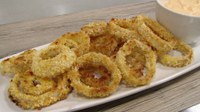Prairie Fare: Try Making Baked Onion Rings
(Click an image below to view a high-resolution image that can be downloaded)
By Julie Garden-Robinson, Food and Nutrition Specialist
NDSU Extension Service
I always will remember the “year of the onions” from my childhood. I helped plant rows and rows of onion sets. I think we must have gotten a good deal on them.
Usually our onions did not grow to be monster-sized, but when harvest time arrived this particular year, we filled the back of our pickup truck with large white onions.
Being a curious kid, I weighed some onions on a scale we had and measured them with a ruler. I was hoping for a Guinness World Records-sized onion, but unfortunately, they were not that big. Many were close to 5 inches in diameter and weighed more than a pound, though.
Everyone who visited the Garden family left with a parting gift (a bag of onions) that fall.
Onions remain a staple in my own cooking. The other day when I arrived home, my husband was grilling an onion bloom. I like when he surprises me with novel recipes that I don’t have to prepare. It was very tasty.
An onion bloom is a large onion cut in a way that it opens during cooking. A grilled onion bloom has far fewer calories than a deep-fried one from a restaurant. You can find a recipe for an herb grilled onion bloom at the National Onion Association website (https://www.onions-usa.org/all-about-onions).
Of course, you do not have to grow your own onions to enjoy them. A variety of onions, including white, yellow and red, are sold in the grocery store. When selecting onions, choose firm ones without blemishes or bruises. Bruised areas are more likely to become spoiled.
Onions provide flavor, vitamins and minerals without adding a lot of calories. One cup of chopped onion has about 64 calories, 15 grams of carbohydrate, 2.7 grams of fiber and 4.9 grams of protein. They provide vitamin C, folate and some iron and calcium.
Onions also contain quercetin, which is a natural antioxidant. The combination of fiber, antioxidants and other natural chemicals may help protect us from heart disease, cancer and other illnesses.
Be sure to store onions in a cool, dry, dark place with good air circulation. You can store them in woven bags, a basket or even a crate. Whole onions can keep for weeks. Store cut onions in a covered container in the refrigerator for up to a week.
To freeze chopped onions, clean them, then chop and place them in freezer bags in recipe-sized amounts. Press out air and leave head space. Label bags with the contents and date and seal. Freeze flat on a cookie sheet, then stack the bags.
If you decide to freeze whole onions, the National Center for Home Food Preservation recommends water blanching them in boiling water about three to seven minutes until the center is heated. Cool promptly and drain. Place in freezer containers, leaving 1/2-inch head space. Label with the contents and date, seal and freeze. These are suitable for use in soups and other cooked dishes.
Green onions can be frozen without blanching, but, of course, they will not be crisp. Peel, wash and chop. Loosely pack and freeze in large freezer bags. Take out as needed.
Finally, if your eyes water during preparation of onions, try chilling the onions for 30 minutes before cutting. Leaving the root end intact, peel the onion. The root end holds the highest concentration of the sulfuric compounds that make you cry.
To freshen your breath after eating onions, the National Onion Association recommends swishing your mouth with lemon water or chewing on a piece of parsley.
Whether you grow your own onions or buy them in a store, here’s a way to use them. This baked onion ring recipe was very popular when my student interns tested recipes. You won’t have to clean a deep-fat fryer in the process of making dinner.
Baked Onion Rings
1 large yellow onion
1/3 c. flour
1 tsp. seasoning salt
1/2 tsp. chili powder
2 c. panko breadcrumbs
2 eggs
2 Tbsp. water
Dipping sauce of your choice (ketchup, barbecue sauce, sweet chili sauce, etc.)
Preheat oven to 450 F. Line a baking sheet with foil and spray with nonstick spray. Peel the outermost layer from the onion and discard. Cut off the ends (sparing as much of the onion as possible) and slice the rest of the onion into thick rings. Separate the rings and place in a bowl of water.
Line up three bowls with these contents:
Bowl 1: Stir together flour, seasoning salt and chili powder.
Bowl 2: Whisk together eggs and water.
Bowl 3: Panko crumbs
One at a time, place each onion ring in the flour mixture, turning to coat well. Next, dip the onion ring in the egg mixture, being sure to coat all sides. Finally, toss the ring in the panko crumbs to coat. Place on prepared baking sheet. Repeat process with remaining rings.
Spray the rings with nonstick spray (optional, but it helps to get them crispy). Bake rings for 10 to 15 minutes until golden brown. Remove from oven and serve with your favorite dipping sauce.
Makes four servings. Each serving has 230 calories, 2.5 grams (g) fat, 9 g protein, 42 g carbohydrate, 2 g fiber and 450 milligrams sodium.
(Julie Garden-Robinson, Ph.D., R.D., L.R.D., is a North Dakota State University Extension Service food and nutrition specialist and professor in the Department of Health, Nutrition and Exercise Sciences.)
NDSU Agriculture Communication - Aug. 4, 2016
| Source: | Julie Garden-Robinson, 701-231-7187, julie.garden-robinson@ndsu.edu |
|---|---|
| Editor: | Ellen Crawford, 701-231-5391, ellen.crawford@ndsu.edu |



